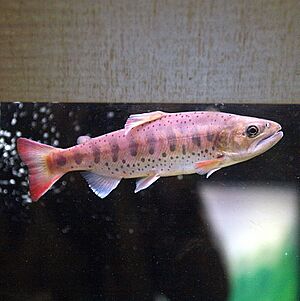Amago facts for kids
Quick facts for kids Amago |
|
|---|---|
 |
|
| Scientific classification |
|
| Kingdom: | Animalia |
| Phylum: | Chordata |
| Class: | Actinopterygii |
| Order: | Salmoniformes |
| Family: | Salmonidae |
| Genus: | Oncorhynchus |
| Species: |
O. masou
|
| Subspecies: |
O. m. macrostomus
|
| Trinomial name | |
| Oncorhynchus masou macrostomus (Günther, 1877)
|
|
The amago (Oncorhynchus masou macrostomus), also known as the red-spotted masu salmon, is a type of salmonid fish. This means it belongs to the same family as salmon and trout. It is found only in western Japan. The amago is a subspecies of the larger masu salmon, which is also called the cherry salmon.
What makes the amago special are its bright red or orange spots. It also has black spots on its body. Another type of masu salmon, called the yamame, only has black spots. Amago fish live in western Japan, near the Pacific Ocean coasts of Honshu and Shikoku islands. They are also found on the Inland Sea of Japan side of Kyushu island.
Some amago fish live their whole lives in streams. Others are anadromous, meaning they travel from freshwater streams to the ocean and then return to freshwater to lay eggs. Amago can grow up to 50 cm (20 in) long. People also raise amago in aquaculture farms.
Contents
Meet the Amago: A Unique Japanese Salmon
The amago is a fascinating fish that has adapted to different environments. Its unique red spots make it easy to tell apart from other salmon. These fish are an important part of Japan's natural world.
Amago's Family Tree: Related Fish
For a while, scientists thought the amago was a subspecies of a fish called Oncorhynchus rhodurus. However, that name now refers only to the Biwa trout. The Biwa trout lives in a smaller area within the amago's range. This shows how scientists sometimes change how they classify animals as they learn more.
Different Names for Similar Fish
Sometimes, you might hear the amago called O. m. ishikawae. This name was used in some Japanese publications. The IUCN Red List, which tracks endangered species, once listed a fish called "Oncorhychus ishikawai" from the Nagara River. This fish was known as the satsukimasu salmon.
However, the name O. m. ishikawae has also been used for other types of black-spotted yamame that do not migrate to the sea. Today, many scientists consider O. m. ishikawae to be the same as O. masou masou. This group includes both the sea-migrating and stream-dwelling black-spotted forms. It can be a bit confusing, but it shows how diverse fish species can be!
The Iwame Trout: A Spotless Cousin
There is a special type of amago called the Iwame trout. This fish is unique because it has no spots at all! It is a recessive morph, which means it's a natural variation that happens when certain genes are passed down. You can find Iwame trout in some upstream populations of amago that do not migrate to the sea.

